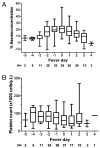Timing of CD8+ T cell responses in relation to commencement of capillary leakage in children with dengue
- PMID: 20483770
- PMCID: PMC4340505
- DOI: 10.4049/jimmunol.0903262
Timing of CD8+ T cell responses in relation to commencement of capillary leakage in children with dengue
Abstract
Immune activation is a feature of dengue hemorrhagic fever (DHF) and CD8+ T cell responses in particular have been suggested as having a role in the vasculopathy that characterizes this disease. By phenotyping CD8+ T cells (CD38+/HLA-DR+, CD38+/Ki-67+, or HLA-DR+/Ki-67+) in serial blood samples from children with dengue, we found no evidence of increased CD8+ T cell activation prior to the commencement of resolution of viremia or hemoconcentration. Investigations with MHC class I tetramers to detect NS3(133-142)-specific CD8+ T cells in two independent cohorts of children suggested the commencement of hemoconcentration and thrombocytopenia in DHF patients generally begins before the appearance of measurable frequencies of NS3(133-142)-specific CD8+ T cells. The temporal mismatch between the appearance of measurable surface activated or NS3(133-142)-specific CD8+ T cells suggests that these cells are sequestered at sites of infection, have phenotypes not detected by our approach, or that other mechanisms independent of CD8+ T cells are responsible for early triggering of capillary leakage in children with DHF.
Figures





Similar articles
-
Dominant recognition by human CD8+ cytotoxic T lymphocytes of dengue virus nonstructural proteins NS3 and NS1.2a.J Clin Invest. 1996 Oct 1;98(7):1684-91. doi: 10.1172/JCI118964. J Clin Invest. 1996. PMID: 8833919 Free PMC article.
-
Characterization of Human CD8 T Cell Responses in Dengue Virus-Infected Patients from India.J Virol. 2016 Nov 28;90(24):11259-11278. doi: 10.1128/JVI.01424-16. Print 2016 Dec 15. J Virol. 2016. PMID: 27707928 Free PMC article.
-
T cell responses to an HLA-B*07-restricted epitope on the dengue NS3 protein correlate with disease severity.J Immunol. 2002 Jun 1;168(11):5959-65. doi: 10.4049/jimmunol.168.11.5959. J Immunol. 2002. PMID: 12023403
-
Differential targeting of viral components by CD4+ versus CD8+ T lymphocytes in dengue virus infection.J Virol. 2013 Mar;87(5):2693-706. doi: 10.1128/JVI.02675-12. Epub 2012 Dec 19. J Virol. 2013. PMID: 23255803 Free PMC article.
-
Understanding the contribution of cellular immunity to dengue disease pathogenesis.Immunol Rev. 2008 Oct;225:300-13. doi: 10.1111/j.1600-065X.2008.00678.x. Immunol Rev. 2008. PMID: 18837790 Review.
Cited by
-
Cross-reactivity and expansion of dengue-specific T cells during acute primary and secondary infections in humans.Sci Rep. 2011;1:51. doi: 10.1038/srep00051. Epub 2011 Aug 1. Sci Rep. 2011. PMID: 22355570 Free PMC article.
-
Generation and characterization of genetically and antigenically diverse infectious clones of dengue virus serotypes 1-4.Emerg Microbes Infect. 2022 Dec;11(1):227-239. doi: 10.1080/22221751.2021.2021808. Emerg Microbes Infect. 2022. PMID: 34931940 Free PMC article.
-
Defeat Dengue and Zika Viruses With a One-Two Punch of Vaccine and Vector Blockade.Front Microbiol. 2020 Mar 20;11:362. doi: 10.3389/fmicb.2020.00362. eCollection 2020. Front Microbiol. 2020. PMID: 32265852 Free PMC article. Review.
-
Dengue and COVID-19: two sides of the same coin.J Biomed Sci. 2022 Jul 3;29(1):48. doi: 10.1186/s12929-022-00833-y. J Biomed Sci. 2022. PMID: 35786403 Free PMC article. Review.
-
Dengue Hemorrhagic Fever at 60 Years: Early Evolution of Concepts of Causation and Treatment.Microbiol Mol Biol Rev. 2015 Sep;79(3):281-91. doi: 10.1128/MMBR.00009-15. Microbiol Mol Biol Rev. 2015. PMID: 26085471 Free PMC article. Review.
References
-
- Srikiatkhachorn A, Krautrachue A, Ratanaprakarn W, Wongtapradit L, Nithipanya N, Kalayanarooj S, Nisalak A, Thomas SJ, Gibbons RV, Mammen MP, Jr., et al. Natural history of plasma leakage in dengue hemorrhagic fever: a serial ultrasonographic study. Pediatr. Infect. Dis. J. 2007;26:283–290. discussion 291-292. - PubMed
-
- Gamble J, Bethell D, Day NP, Loc PP, Phu NH, Gartside IB, Farrar JF, White NJ. Age-related changes in microvascular permeability: a significant factor in the susceptibility of children to shock? Clin. Sci. (Lond.) 2000;98:211–216. - PubMed
-
- Loke H, Bethell D, Phuong CX, Day N, White N, Farrar J, Hill A. Susceptibility to dengue hemorrhagic fever in Vietnam: evidence of an association with variation in the vitamin d receptor and Fc gamma receptor IIa genes. Am. J. Trop. Med. Hyg. 2002;67:102–106. - PubMed
-
- Loke H, Bethell DB, Phuong CX, Dung M, Schneider J, White NJ, Day NP, Farrar J, Hill AV. Strong HLA class I–restricted T cell responses in dengue hemorrhagic fever: a double-edged sword? J. Infect. Dis. 2001;184:1369–1373. - PubMed
-
- Graham RR, Juffrie M, Tan R, Hayes CG, Laksono I, Ma’roef C, Erlin, Sutary, Porter KR, Halstead SB. A prospective seroepidemiologic study on dengue in children four to nine years of age in Yogyakarta, Indonesia I. studies in 1995-1996. Am. J. Trop. Med. Hyg. 1999;61:412–419. - PubMed
Publication types
MeSH terms
Substances
Grants and funding
LinkOut - more resources
Full Text Sources
Other Literature Sources
Research Materials

